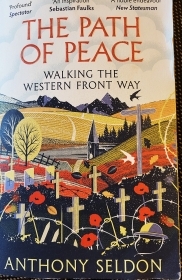Walking along the path of peace along the Western Front
WHEN I SPOTTED THE book in the shelves of a charity shop in the small town of Bruton (in Somerset), I knew I had to buy it. It is written by Anthony Seldon, the youngest son of my parents’ dearest friends, Marjorie and Arthur Seldon. I have known them and Anthony since I was a very young child. The book I purchased is called “The Path of Peace. Walking the Western Front Way”.

In 2021, when Europe was in the midst of the covid19 pandemic, Anthony decided to walk from the Swiss Border to the North Sea, following the path of the Western Front such as it was during WW1. His aim was to help establish a ‘Path of Peace’, to realise the idea formulated during the war by one of the millions who died during it (in 1915), Douglas Gillespie. His idea was, so he wrote to his parents, to establish:
“… a path along No Mans Land from Switzerland to the English Channel after the war was over.”
Douglas wrote to his old headmaster at Winchester College that when the path was established:
“… I would like to send every man [woman] and child in Western Europe along that Via Sacra, so that they might think and learn what war means from the silent witnesses on either side.”
And Anthony explained that the walk he undertook was to help fulfil this noble ambition of poor Gillespie who perished in the conflict.
The book describes Anthony’s arduous walk along the Western Front. It was arduous physically, as the author explained in graphic detail. His feet suffered greatly, almost as much as those of the soldiers who had to spend long periods in the unhygienic trenches. It was also arduous for Anthony because he had recently lost his first wife, Joanna, who had succumbed to an illness (not covid19). The various governmental restrictions imposed to control the pandemic added to his difficulties. Yet, despite many businesses having shut down in France because of the virus, he managed (occasionally with difficulty) to find food and accommodation along the way.
Anthony describes many interesting aspects of the history of WW1 as he made his way north from Switzerland to the North Sea. He mentions what has become of the many places that were heavily destroyed by the artilleries of the armies fighting each other. Intertwined with these historical facts of an impersonal nature, he relates the poignant histories of his parents’ families during the war. For example, he describes how his father was orphaned when his parents died during the Spanish Flu, the spread of which was facilitated by wartime conditions. He also describes how his mother’s father was badly wounded in France and how his wife, Anthony’s grandmother, defied British officialdom and rescued her wounded husband from war torn France. These aspects of Anthony’s family history were known to me before I found the book, but what her wrote adds greatly to what I already knew.
Throughout the book, Anthony muses on the horrors of warfare and its tragic consequences. Yet, the book is not as gloomy as its subject matter might suggest. As the reader follows his progress along a frequently ill-signposted trail, he or she gets to know Anthony better: his strengths and his self-confessed weaknesses. Anthony’s book is both fascinating and moving. I am glad I bought my copy when I saw it in Bruton.



